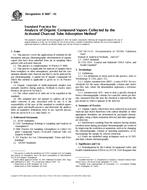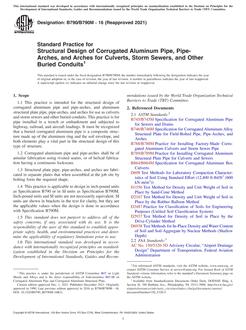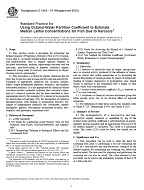1.1 This practice describes the techniques for planning, conducting, analyzing, and treating the results of an interlaboratory study (ILS) of a test method. The statistical techniques described in this practice provide adequate information for formulating the precision statement of a test method.
1.2 This practice does not concern itself with the development of test methods but rather with gathering the information needed for a test method precision statement after the development stage has been successfully completed. The data obtained in the interlaboratory study may indicate, however, that further effort is needed to improve the test method.
1.3 Since the primary purpose of this practice is the development of the information needed for a precision statement, the experimental design in this practice may not be optimum for evaluating materials, apparatus, or individual laboratories.
1.4 Field of Application – This practice is concerned exclusively with test methods which yield a single numerical figure as the test result, although the single figure may be the outcome of a calculation from a set of measurements.
1.4.1 This practice does not cover methods in which the measurement is a categorization, such as a go-no-go allocation (two categories) or a sorting scheme into two or more categories. For practical purposes, the discontinuous nature of measurements of these types may be ignored when a test result is defined as an average of several individual measurements. Then, this practice may be applicable, but caution is required and a statistician should be consulted.
1.5 The information in this practice is arranged as follows:
| Section | |
| Scope | 1 |
| Referenced Documents | 2 |
| Terminology | 3 |
| Summary of Practice | 4 |
| Significance and Use | 5 |
| Planning the Interlaboratory Study (ILS) | Section |
| ILS Membership | 6 |
| Basic Design | 7 |
| Test Method | 8 |
| Laboratories | 9 |
| Materials | 10 |
| Number of Test Results per Material | 11 |
| Protocol | 12 |
| Conducting the Testing Phase of the ILS | Section |
| Pilot Run | 13 |
| Full Scale Run | 14 |
| Calculation and Display of Statistics | Section |
| Calculation of the Statistics | 15 |
| Tabular and Graphical Display of Statistics | 16 |
| Data Consistency | Section |
| Flagging Inconsistent Results | 17 |
| Investigation | 18 |
| Task Group Actions | 19 |
| Examples of Interlaboratory Studies | 20 |
| Precision Statement Information | Section |
| Repeatability and Reproducibility | 21 |
| Appendixes | Appendix |
| Theoretical Considerations | X1 |
| Index to Selected Terms | X2 |
| References | |
| Tables and Figures | |
| Table | |
| Glucose in Serum Example | 1–4, 6–7, 11 |
| Pentosans in Pulp Example | 8–10, 12 |
| Critical Values of Consistency Statistics, h and k | 5 |
| Figure | |
| Glucose in Serum Example | 1–4, 8 |
| Pentosans in Pulp Example | 5–7, 9 |
1.6 This standard may involve hazardous materials, operations, and equipment. This standard does not purport to address all of the safety problems associated with its use. It is the responsibility of the user of this standard to establish appropriate safety and health practices and determine the applicability of regulatory limitations prior to use.
Product Details
- Published:
- 11/01/2011
- Number of Pages:
- 23
- File Size:
- 1 file , 240 KB
- Redline File Size:
- 2 files , 560 KB


